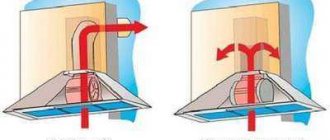Share
Tweet
+1
Pin
Placing equipment in the kitchen is not an easy task. Often at this stage a dilemma arises whether it is possible to place the oven next to the refrigerator. The space of the kitchen requires the arrangement of all necessary furniture and appliances in such a way as not to violate safety regulations.
Why is it undesirable to have a refrigerator and oven next to each other?
Equipment manufacturers do not recommend placing a refrigerator and an oven next to each other. Since both of these types of household equipment have different operating features. The heat generated by each of them during operation can adversely affect the system of a neighboring device, creating unnecessary load. Which can ultimately lead to wear and tear on the equipment’s mechanisms and its rapid breakdown.
The cooling system of modern refrigerators tends to give off heat, which is accompanied by heating of the back wall. If influenced from the outside, the power of the compressor will increase, causing overheating of the equipment. Accordingly, a small distance between the appliance and the oven leads to a decrease in service life.
It is important to know! When planning the purchase of these electrical appliances, you should pay attention to the accompanying instructions. As a rule, it indicates the minimum distance from each other recommended by the manufacturer, as well as other possible restrictions.
As a rule, the distance noted in the operating instructions is no less than 0.5 m. Any surface such as a table or kitchen cabinet can be used to separate devices. Failure to comply with these rules and close placement of electrical equipment is a reason for service centers to refuse to provide free repairs within the warranty period. Owners of small kitchens are forced to use resourcefulness and use built-in appliances as elements to isolate the refrigerator from the oven.
What distance should be between the gas stove and the refrigerator?
Ideally, the kitchen space is organized according to the working triangle rule . The kitchen is divided into three zones, each of which does not intersect with the others. The first top is the refrigerator, cabinets, the second is the stove, the third is the sink. The distance between sectors is 1.8-2 m.
In practice, it is not always possible to achieve such a layout. The permissible distance between the refrigerator and the gas stove is 30-50 cm. Most manufacturers recommend sticking to 50 cm for their models.
Important! For normal operation of a refrigeration compressor, good air exchange is necessary.
Placement of built-in devices
The answer to the question about placing a refrigerator and oven next door will be positive if one of these appliances is built-in. Thus, modern built-in ovens are endowed with special heat-protective properties and are additionally equipped with a heat-insulating layer. Which creates a barrier to the spread of heat in the external environment. The same applies to built-in refrigerators that have additional thermal insulation in their external elements. This will also allow you to place the device in close proximity to the oven. But what can be used to create insulation if the placement of these two electrical appliances is unavoidable?
It is necessary to create a distance of at least 15 cm. The following tips will be useful in solving this problem:
- A shelf or cabinet will create the necessary gap between appliances and add additional functionality to the kitchen interior.
- A furniture partition in the form of which you can use a frame for installing household appliances, made of wood. This will protect the devices from unwanted thermal effects.
- Insulating the wall of the refrigerator that is closest to the oven will reduce the risk of excessive heat. To do this, you will need heat-reflecting foil.
Modern household appliances can be installed nearby, but it is worth considering the operating requirements and following safety rules. Based on simple recommendations, placing an oven and refrigerator in the kitchen will not be difficult.
Ideas for a miniature kitchen
Thermal insulation materials will come to the rescue. They are glued to the side wall of the refrigerator. They create a protective layer and prevent heating. Such materials are of organic and inorganic nature.
The first include textolite, polystyrene foam, and cork. They are hygroscopic and non-toxic. However, over time they lose their shape and without cladding they look unaesthetic and grayish. If you value the beauty of your kitchen, cover them with decorative film, laminate them or decorate them with a profile.
The second ones are fiberglass, asbestos board, plasterboard, and isolon. They can withstand high temperatures, do not burn and are inexpensive, but they will provide full protection only if the humidity in the room does not exceed 50%.
The selected material is glued using double-sided tape. It will not only fix the thermal insulation layer on the wall of the refrigerator, but also allow it to be removed if necessary.
There is no need to attach a sheet of insulation to the slab. Due to constant heating, the tape will lose its adhesive properties.
Important! Do not use “liquid” nails or glue to attach the protective layer. You may have to rearrange at some point.
An interesting solution is a protective screen made of foil material or mirrors that perfectly reflect heat. Here hooks and magnets act as fastenings. A powerful hood installed in the kitchen will help out. It will absorb the heat from cooking.
What is the energy consumption of refrigerators?
Refrigerator power consumption
Refrigerators are a necessary element in every Indian home. What was invented as a simple cooling device has evolved technologically over the decades to serve a variety of functions. Today, refrigerators are available in various sizes, structure and views. With countless options available in the market, it is not difficult to choose the right refrigerator for your home. If you are not sure about the choice, then read our article - Best Refrigerators in India which will help you make an informed decision.
However, since refrigerators are used 24/7 for 365 days, there is another factor consumers need to consider before investing in one.
Electricity supply in India is unreliable and hence it is important to invest in refrigerators that can withstand power outages and surges. Needless to say, the energy consumption of refrigerators is something that needs to be looked at as they are vital to saving and conserving energy in the country. Energy efficient refrigerators are best represented by using high star ratings.
Decoding the electricity consumption of refrigerators
Typically, refrigerators add up to 15% of your monthly energy bill. Ideally, household refrigerators consume about 100-200 W of electricity. However, it is important to understand that refrigerators do not use energy constantly. Electricity is consumed when the compressor needs to turn on or when the interior is exposed to outside temperatures. So, based on several factors, including the brand of the refrigerator, the energy consumption can be calculated.
You can use a power meter to check the refrigerator's performance, or you can calculate the power consumption manually. All you need to know is the average power consumption of the refrigerator. This can be achieved by dividing the annual consumption rate shown on your BEE rating label by the number of days used.
For example: annual power consumption = 700 kWh
Number of days used = 300
Average refrigerator power = 2.3 kW / 2300 W per day
How to determine an energy efficient refrigerator?
Energy efficient refrigerators come with a Government approved BEE Star Rating which reflects the efficiency of the refrigerator in terms of energy consumption. Refrigerators are rated on a five-point scale, with the highest rating indicating their high efficiency. It's always advisable to invest in refrigerators rated 4 or higher, although they may cost a little more.
BEE Star Rating
star rating
was introduced in India in 2006 to help identify cost-saving and energy-saving potential for electrical appliances. This efficiency measure was a long-awaited initiative by the Department of Energy to promote the production of energy-efficient household electrical appliances.
As mentioned earlier, the higher the rating, the higher its effectiveness. These ratings are shown on the label, which includes information about annual energy consumption, brand name, category and other practical details. On the BEE label, find the number of stars in the color space. The more stars on a color bar, the higher its efficiency. The next aspect that will be indicated on the label is the annual power consumption in units per year (1000 watts per hour = 1 unit). Next is the BEE logo. However, BEE star ratings are only available for frost-free refrigerators.
Power consumption is calculated based on the compressor, coolant efficiency (HFC), energy loss during transmission, and the material used to construct the refrigerator. On the other hand, these ratings also designate eco-friendly appliances that reduce emissions of CFCs and other pollutants into the environment .
It is known that modern refrigerators have evolved enough to save about 70% of energy. If a 25-year-old refrigerator consumes about 1,400 kilowatts per year of electricity, we can be sure that the latest model of the same capacity can operate efficiently, using only 350-700 kilowatts per year, depending on the rating.
The following table, outlining the energy and cost savings potential of a 250-quart frost-free refrigerator with various features, will give you an accurate idea of how star ratings affect the efficiency of the unit. Considering that per unit charge the electricity will be around Rs. 2.5 and comparing them to a refrigerator without stars that consumes 1100 kWh per year and costs you a bill of Rs 2750 per year, we get
rupees rupees rupees
| Star rating | Annual energy consumption (approx.) | Annual electricity cost (approx.) | Saving | Refrigerator cost (approx.) | Cost difference | Payback period (in years) |
| 1 | 977 | Rs 2433 | Rs 308 | rupees 15000 | rupees 1000 | 3.25 |
| 2 | 782 | Rs 1955 | Rs 795 | rupees 15500 | rupees 1500 | 1,89 |
| 3 | 626 | Rs 1565 | Rs 1185 | rupees 16500 | rupees 2500 | 2,11 |
| 4 | 501 | Rs 1253 | Rs 1498 | rupees 17500 | rupees 3500 | 2,34 |
| 5 | 400 | rupees 1000 | Rs 1750 | rupees 18500 | rupees 4500 | 2.57 |
Source: Bureau of Energy Efficiency
Inverter refrigerators vs conventional refrigerators
Talking about energy saving, inverter refrigerators are the latest in home appliances. Inverter technology developed in Japan is quite advanced and can save up to 30-50% energy compared to conventional refrigerators. Needless to say, inverter refrigerators are expensive. So, which refrigerator is more energy efficient? Let's first find out how refrigerators work.
Conventional Refrigerators: In general, a refrigerant called hydrofluorocarbon (HFC) in liquid form absorbs all the heat inside the refrigerator and converts it into gas. The compressor then works to convert the gas into liquid HFC form. However, the electricity is only turned on during the compressor portion of the cycle. Compressors in conventional refrigerators operate at their peak, regardless of the external environment, when cold air inside the appliance is lost.
Inverter Refrigerators: On the other hand, compressors with this technology work as per the requirements. Considering the summer environment, the compressor works at high load to maintain a certain temperature inside the refrigerator. But winters do not encourage the compressor to work constantly, since the ambient temperature is also quite low. Thus, electricity consumption is less in inverter technology. Despite their efficiency, thanks to the variable speed compressor, inverter refrigerators are not BEE rated.
PLEASE NOTE: The BEE rating is based on annual energy consumption and not compressor efficiency.
Due to the very nature of the difference between annual energy consumption and compressor efficiency, the Ministry of Energy has developed a new rating method called the India Seasonal Energy Efficiency Index (ISEER). This rating now applies to all types of household electrical appliances, including air conditioners.
Let's take a look at the difference between a high BEE rated refrigerator and an inverter refrigerator.
| Peculiarity | BEE Rated refrigerator | Inverter Refrigerator |
| Noise | Makes a significant amount of noise. | Quiet operation |
| Compressor efficiency | Comparatively less | Very tall |
| Compressor speed | Corrected | Depends on external environment and requirements |
| Automatic shutdown | Yes, the compressor turns on/off as needed | Compressor frequency remains constant |
| Star rating | BEE rated | Not applicable |
| price | Accessible | Expensive |
| Energy saving power | Worthy | Very tall |
Energy Saving Tips to Save Refrigerator
Here are some simple yet great energy saving techniques to reduce and keep your maintenance costs low.
Keep your temperature settings under control
The temperature level of your refrigerator plays a crucial role in determining your energy bill. Maintaining unnecessary cold temperatures can increase your energy consumption and, in turn, your bill. The ideal temperature of a refrigerator should be between 2-4℃, while the freezer should always maintain a temperature between -15℃ and -17℃. If the temperature inside the refrigerator is too high or too low, there is a high chance that your food will spoil as well. If you need to check the temperature inside the unit, place the thermometer in a glass of liquid (water) and leave it for 24 hours. Similarly, place a thermometer between two frozen ice cubes or any food item for 24 hours to check the freezer temperature.
Keep your refrigerator stocked
Yes, as strange as it may sound, the more you store in your refrigerator, the more efficient you will be at finding it. However, overcrowding should be avoided by allowing air to circulate evenly throughout the refrigerator. A loaded refrigerator will maintain the ideal temperature better than an empty one. If you find that your refrigerator is almost empty, fill them with water containers or other liquid items. This will improve the adaptability of the device. It is also important to cover your liquids and other food items before storing them. Opened food tends to dry out, and the loss of moisture in turn makes it harder for the compressor to operate, which impacts energy consumption.
Place your refrigerator strategically
Installation around refrigerators makes a huge difference in determining their efficiency. These appliances need space around them to help with air circulation. Overcrowding the space by placing it between cabinets or storage can hinder its performance. Additionally, it is important not to keep refrigerators near any heat-producing objects such as an oven, stove, etc., placing them directly under sunlight is also not recommended. A small 10℃ change in temperature around the refrigerator can require 20% more electricity.
Regular Maintenance
Refrigerators
have metal condenser coils located at the back that help get rid of the heat generated by the compressor. Keeping the coils clean is an important step to ensure your refrigerator lasts long and performs efficiently. Cleaning them once a year should prevent overloading the compressor. Whether you have a refrigerator with automatic defrosting or you have to do it manually, make sure your refrigerator goes through a regular freeze and defrost cycle to improve its efficiency. Ice buildup should never exceed more than 0.25 inches in the evaporator . The higher the ice accumulation, the more energy is required to keep the engine running.
Keep the doors closed
It may seem small, but it plays an important role in maintaining the temperature in your refrigerator. Frequent and unnecessary opening of refrigerator doors allows cold air to escape, making it difficult for the compressor to operate to replace it. Also, make sure the gasket around the door is tight enough to prevent air from escaping. A torn or worn gasket (seal) will not trap the generated cold air, which will spoil food and contribute to increased energy consumption.
Turning off the ice maker
While ice makers are a boon on days when you need a quick and large supply of ice for a limited period of time, ice makers use more electricity than your regular refrigerator. Automatic ice makers are known to improve energy efficiency by 15-20%. So you should probably consider turning it off when not needed or when the tray is full.
Do not store hot food immediately
Allow food to cool before storing it in the refrigerator. No matter how busy and in a hurry you are. Overuse of the device will lead to early deterioration in performance. Hot air and moisture inside the refrigerator will make it difficult for the compressor to operate and consume more electricity.
Activate power saving mode
Most modern refrigerators come with an energy-saving mode that helps turn off the heater from sweat. Older models used heaters to avoid condensation inside the unit when opening the door and cooling the cold air in the refrigerator. New appliances with energy-saving mode reduce the need for a heater and, in turn, the need for additional energy consumption.
Keep your refrigerator organized
No, this is not an article about good housekeeping, but did you know that a well-organized refrigerator saves energy? To ensure maximum efficiency, store foods in appropriate areas, such as condiments and juices, facing the door (warmest part), and leftovers should be stored in the main top unit. The bottom shelves are the coldest part of the refrigerator, other than the freezer. They are ideal for storing dairy and meat products. Fruits and vegetables should be stored separately.
Consider the size
A nuclear family of four can do with a 320/360 liter refrigerator. Keep your requirement in mind before purchasing the appliance. Although three-door refrigerators look modern and make good home decor, their efficiency is much lower than single-door or two-door refrigerators. Large refrigerators, which contain almost no items, require more energy to maintain a certain temperature than small ones, which are stored to full capacity. Also, keep in mind that three-door refrigerators are not BEE rated.
Device form
Although the design and shape of a refrigerator does not directly affect its efficiency, it does make a big difference in saving energy. Refrigerators with top and bottom configuration are considered to be more energy efficient than parallel refrigerators. This is due to the placement of the compressor plays an important role in determining its efficiency.
Conclusion
Refrigerators are a blessing over the years, but they require a little care and attention to function effectively for a longer period of time. The Government of India has made it easy for us to take decisions based on the demand of power. Make sure your refrigerator's power consumption matches the power supply in your area. A good BEE refrigerator can easily last up to 10 years with regular maintenance without burning a hole in your pocket.
,










